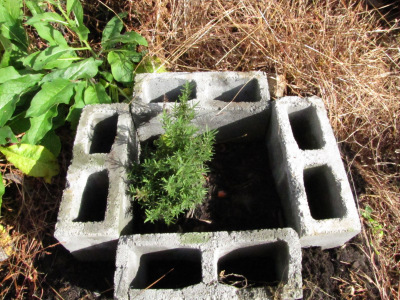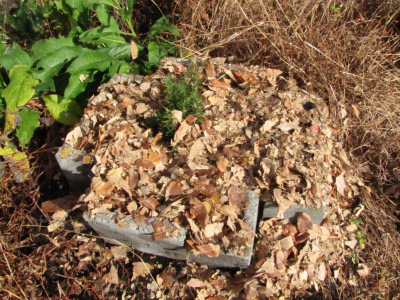
Rosemary winter protection
 Here
in zone 6, we're right on the edge of rosemary's hardiness area.
Despite the fact that friends of mine fifty miles south can grow huge
bushes of rosemary where nearby pavement holds in heat around their
city yards, I've never managed to get mine to survive the winter.
Our shady valley chills down fast and stays cold all winter --- we've
had four frosts already that have completely taken out the summer
garden while my city friends are still lingering on the edge of summer.
Here
in zone 6, we're right on the edge of rosemary's hardiness area.
Despite the fact that friends of mine fifty miles south can grow huge
bushes of rosemary where nearby pavement holds in heat around their
city yards, I've never managed to get mine to survive the winter.
Our shady valley chills down fast and stays cold all winter --- we've
had four frosts already that have completely taken out the summer
garden while my city friends are still lingering on the edge of summer.
This year, I decided to
start experimenting with ways of protecting rosemary so that it will
survive the winter outdoors. The first step was too keep its
roots very dry. I built hugelkultur mounds in the sunniest (but also
most waterlogged) part of the garden. For the first time ever, my
rosemary thrived through the summer, turning from a rooted cutting into a nice little
bush. The soil felt bone dry when I rooted around in it, but the
rosemary seemed to get plenty of moisture.
 Now
that cold weather is on its way, I made a little den for the rosemary
out of four cinderblocks liberally filled with autumn leaves.
(Thanks for collecting those, Mom!) I hope the plant won't mind
not being able to photosynthesize with its lower leaves, and that the
combination of cinderblock thermal mass and leaf insulation will keep
the roots from freezing.
Now
that cold weather is on its way, I made a little den for the rosemary
out of four cinderblocks liberally filled with autumn leaves.
(Thanks for collecting those, Mom!) I hope the plant won't mind
not being able to photosynthesize with its lower leaves, and that the
combination of cinderblock thermal mass and leaf insulation will keep
the roots from freezing.
I also hedged my bets a
month ago by buying two cold hardy rosemary varieties from a nearby
nursery --- Hill Hardy and Arp. I've read various reports on the
internet, some of which suggest that these varieties will survive the
winter in zone 6, and others that are less promising. If I'd
known what I was doing, I would have planted these hardy rosemary
plants in the spring like I did my homegrown cutting so that they would
have all summer to get established --- that's what I'll try next year
if my insulating barriers fail to protect our three rosemary plants
through the winter. If even that fails, I'll let Mark build me
the mini-greenhouses he's been dying to make to keep our delicious herb
green all year.
Want more in-depth information? Browse through our books.
Or explore more posts by date or by subject.
About us: Anna Hess and Mark Hamilton spent over a decade living self-sufficiently in the mountains of Virginia before moving north to start over from scratch in the foothills of Ohio. They've experimented with permaculture, no-till gardening, trailersteading, home-based microbusinesses and much more, writing about their adventures in both blogs and books.
Want to be notified when new comments are posted on this page? Click on the RSS button after you add a comment to subscribe to the comment feed, or simply check the box beside "email replies to me" while writing your comment.

Wow. We've barely had a light frost here in Floyd. Still have living peppers and eggplants. Gotta move them in a couple hours.
They use rosemary in Tucson as a low water / low maintenance plant for public walkways so no wonder yours was happy without too much water. They are an arid land bush!
I'd go for the mini-greenhouse. Build a wooded frame and cover it with a sheet of PMMA (perspex, plexiglass)
Build a wooded frame and cover it with a sheet of PMMA (perspex, plexiglass)
Interesting. I didn't know about greenhouses accumulating pests. There are new things to learn every day
As for watering, since the pane of acrylic gets all the water that the plot normally would get, it shouldn't be that difficult to add a roof gutter to the lower side of the cover and pipe that water inside...
A well-planned organic garden is a balancing act, and things like chemical fertilizers, pesticides, and greenhouses tip it out of balance. In my garden, I don't worry about most pest insects because natural predators come along very quickly and eat them up. But in a greenhouse situation, things like whiteflies and aphids that barely tough my garden tend to get out of control --- they lack natural predators and you have to go through and wash them off by hand or spray insecticidal soap. I was shocked the first spring that I tried to start a lot of seedlings inside and lost most of them to problems that never would have touched my garden. I've since discovered that I actually get better yields by just starting most of those plants in cold frames in the garden, where the conditions aren't so unnaturally warm and where some beneficial insects pop up along with the bad.
That said, your idea of a gutter on the minigreenhouse that makes it self watering is extremely tempting....